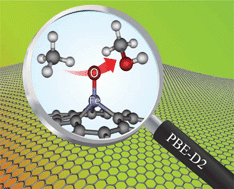Direct oxidation of methane to methanol on Fe–O modified graphene†
Abstract
Introduction of functional groups to graphene can be used for the rational design of catalysts for the oxidation of hydrocarbons to alcohols. We have employed the PBE-D2 level of theory to study the direct oxidation of CH4 to CH3OH on a Fe–O active site generated on graphene by the decomposition of nitrous oxide (N2O) over Fe-embedded graphene. Restricted and unrestricted spin state of systems were also taken into account. The calculations show that FeO/graphene provides excellent reactivity for the oxy-functionalization of methane to methanol. The oxygen-centered radicals (O−˙) on the catalyst can activate the strong C–H bond of methane leading to its homolytic cleavage. The C–H bond activation requires an energy of 17.5 kcal mol−1, which is comparable with the barrier on traditional effective catalysts. Comparing the molecular adsorption complex, the formation of the iron coordinated fragments of C–H bond activation on the graphene support is found to be less energetically stable than on the Fe sites in the zeolite support. As a result, the conversion of the grafted species to the methanol product in the second step of the reaction is much more facile than for Fe-exchanged zeolite catalysts. An activation energy of 16.4 kcal mol−1 is required to yield the methanol product. Fe–O modified graphene materials could be promising catalysts for the partial oxidation of methane with N2O as an oxidant.


 Please wait while we load your content...
Please wait while we load your content...